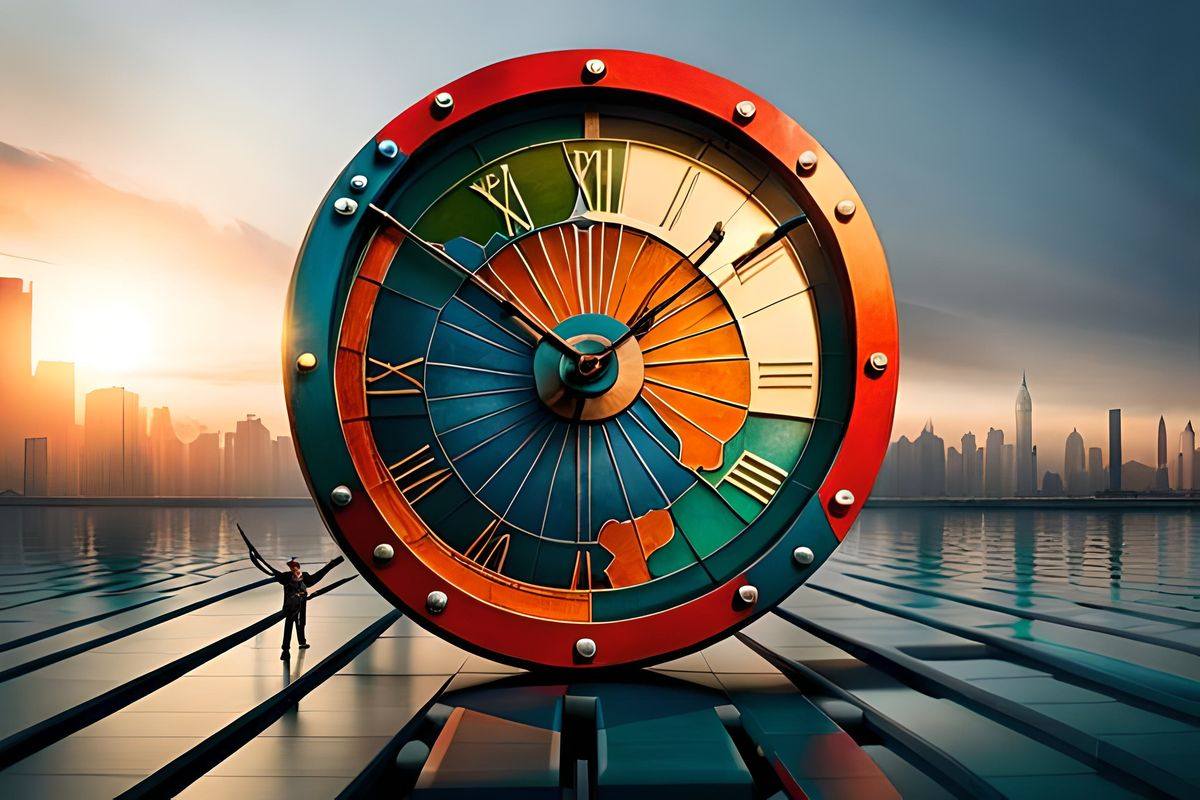One of the easiest ways to time travel would be to take a step from China to India, and you would have managed to travel 2 hours 30 minutes in time. Technically, this is not a time travel but one of the fascinating outcomes of different time zones across our planet.
Time, an intangible yet universal concept, governs our lives in ways we usually take for granted.
Across the globe, time zones carve the Earth’s surface into segments, each with its own unique temporal identity.
However, India, a vast subcontinent with a rich diversity of cultures, climates, and landscapes, stands as one of the exceptions. The other, India’s neighbor China is also one that stands out.
China’s only timezone is UTC+08:00, and it spans five nominal time zones. For China, it mostly “works” because 90% of the Chinese population lives along China’s east coast, although it is odd when you visit Western China in the late spring, and the sun rises at 8:30 AM.
India’s only time zone is UTC+ 05:30, and covers 29 degrees of longitude or two equivalent time zones. Countries like France and Russia have 12 and 11 timezones respectively.
The question arises as to why and does having this single timezone actually helps India or whether are there any serious disadvantages.
Understanding Time Zones
Time zones, the result of our planet’s rotation, divide the world into longitudinal segments, each roughly 15 degrees apart.
As one moves east or west, time advances or retreats by an hour. This division aims to synchronize our daily routines with the natural progression of day and night.
India the 7th largest country in the world, intriguingly, sticks to a solitary time zone, despite its vast geographical extent. While most countries adjust their clocks to suit their local solar time, India maintains a uniform time throughout the nation.
The single time zone currently in use is based at a longitude passing near the city of Allahabad (almost 82°).
The Rationale for a Single Time Zone in India
Historically, India’s single time zone originated from a desire for administrative simplicity. When the British established the Indian Standard Time (IST) in 1905, they aimed to streamline railway schedules, telegraph communication, and administrative operations across the subcontinent.
This decision was rooted in the colonial era’s need for centralized governance, administrative control, and efficient resource allocation.
A single time zone allowed for uniformity and coordination across the nation’s expansive geography and helped manage its imperialistic goal of simplicity and efficiency.
Furthermore, majority of India’s major cities (Delhi, Bangalore, Hyderabad, Mumbai, Chennai) are relatively close to the central longitude. This is the same case for China, where most of its economy is centered around the Beijing longitude which lowers the impact of solitude time zone adoption.
Modern Challenges Posed by a Single Time Zone
India’s single time zone, however, has not been without its share of challenges. Due to its vast geographical span, the sunrise and sunset times vary significantly from east to west. The eastern states experience early sunrise and sunset, while the western regions enjoy a more leisurely progression of daylight.
These variations affect various aspects of daily life. In the northeast, where daylight arrives early, people often begin their routines well before dawn, impacting sleep patterns and work-life balance. Conversely, in the western parts of the country, businesses may extend working hours into the evening due to later sunsets.
The “Dong” village of Arunachal Pradesh sees sunrise 2 hours before “Guhar Moti” village of Gujarat.
Critics of the single time zone have argued that India should move to two different standard times to make the best use of daylight in eastern India, where the sun rises and sets much earlier than in the West. People in the East need to start using their lights earlier in the day and hence use more electricity.
The rising and setting of the sun impacts our body clocks or circadian rhythm. As it gets darker in the evening, the body starts to produce the sleep hormone melatonin – which helps people nod off.
Economically, India’s single time zone creates hurdles. Stock markets, for instance, operate on IST, leading to a considerable time gap between their opening and the opening of global markets, which follow different time zones. This can affect investment decisions and economic outcomes.
The actual timezone of North Eastest states of India is about an hour ahead of the GMT+5:30 which in turn results in wastage of a lot of daylight, thus affecting the productivity.
Many government and private offices are forced to open even when the daylight gets low, which results in unnecessary power wastage. By changing the time zone, they will be able to make most of the natural daylight.
In a new paper, Maulik Jagnani, an economist at Cornell University, argues that a single time zone leads to a decline in the quality of sleep, especially of poor children. This, he says, ends up reducing the quality of their education.
This is how it happens. The school day starts at more or less the same time everywhere in India, but children go to bed later and have reduced sleep in areas where the sun sets later. An hour’s delay in sunset time reduces children’s sleep by 30 minutes.
India has been engaged in a prolonged discussion about the possibility of adopting two time zones. (Interestingly, tea gardens in the northeastern state of Assam have been independently setting their clocks one hour ahead of Indian Standard Time, effectively creating their own informal time zone.)
In the late 1980s, a group of researchers from a prominent energy institute recommended the implementation of a time zone system as a means to conserve electricity. However, in 2002, a government committee dismissed a similar proposal, citing logistical complexities.
Some experts were concerned about potential railway accidents arising from the need to adjust times at each crossing when transitioning between different time zones.
In 2018, India’s official timekeepers themselves suggested two time zones, one for most of India and the other for eight states, including seven in the more remote north-eastern part the country. Both the time zones would be separated by an hour.
Researchers at the National Physical Laboratory voiced that the single time zone was “badly affecting lives” as the sun rises and sets much earlier than official working hours allow for.
Cultural and Societal Implications
Culturally, the single time zone affects traditions and festivals. Makar Sankranti, for example, is celebrated with great fervor across India, yet the timing of the festival’s ceremonies can differ significantly from one region to another due to variations in sunset times.
Societal routines, such as meal times and daily activities, can also be disrupted. The concept of ‘Indian stretchable time,’ where punctuality is somewhat relaxed, may partially stem from the varying perceptions of time induced by the single time zone.
Calls for Multiple Time Zones
In recent years, there have been calls for India to adopt multiple time zones to address these challenges. Advocates argue that dividing the country into two or more time zones, aligning more closely with local solar time, could mitigate many of the issues arising from the single time zone.
A multi-time zone approach could benefit sectors like agriculture, where daylight hours significantly affect productivity. By allowing regions to set their time according to local sunrise and sunset times, farmers could maximize daylight for their work.
The Feasibility and Implementation Challenges
While the idea of multiple time zones holds promise, it’s not without hurdles. Implementing this change would require significant adjustments, from altering daily routines to adapting infrastructure and communication systems. Coordinating activities across time zones within the same country could also pose challenges.
Looking abroad, countries like the United States and Russia successfully manage multiple time zones, offering examples of how this could work in India. However, India’s unique size and complexity must be taken into account.
Managing multiple time zones within a country can make coordination and communication more complex. Government agencies, businesses, and individuals must always be aware of the time difference when scheduling meetings, events, or transactions.
Technological systems, including computer networks and software, must account for multiple time zones, which can be challenging to implement correctly and maintain.
Global Perspectives
Comparing India’s single time zone to other nations, it becomes apparent that India is a global outlier. Most countries, especially those of comparable size and diversity, employ multiple time zones to better serve their populations.
India’s single time zone can also complicate international interactions, as businesses and individuals must contend with the time difference when communicating or trading with partners abroad.
Public Opinion and Political Will
Public opinion on the matter is mixed. Some argue that a single time zone is symbolic of India’s unity, reinforcing the concept of ‘one nation, one time.’ Others believe that a more nuanced approach to time would better serve the nation’s diverse needs.
Politically, the issue has been debated but has yet to result in significant action. Changing the time zone system is a complex endeavor, requiring consensus and careful planning.
India’s single time zone, born out of historical necessity, presents both unifying and divisive aspects. While it simplifies administration and fosters a sense of national unity, it also creates challenges in terms of daily life, economics, and cultural practices.
The idea of multiple time zones, while appealing to some, faces substantial implementation hurdles. As India continues to grow and evolve, it may be time to revisit the question of whether a single time zone truly serves the nation’s best interests or if it’s time to adapt to a more diverse temporal landscape.
In the end, the question of whether India’s single time zone is a unifying force or a constraint to progress remains a matter of perspective, and the debate is likely to continue in the years to come.



